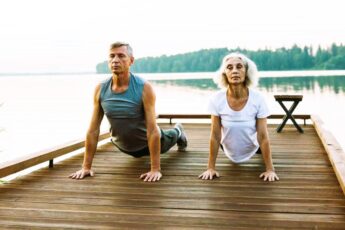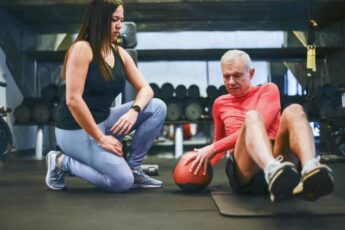Last Updated on March 3, 2024 by Local Trainer
Are you over 55 and looking for an exercise guide that will help you stay fit and active? Look no further! In this ultimate exercise guide, we have curated a variety of workouts specifically tailored for people in their golden years. Whether you are new to exercise or have been active your whole life, these exercises are designed to keep you strong, flexible, and energized.
At Local Trainer, we understand the unique needs of individuals over 55 and have created this guide to support you on your fitness journey. Our workouts are backed by science and developed by experienced fitness professionals, so you can trust that you are in good hands.
From low-impact cardio exercises to strength training routines, this guide covers it all. We have included modifications for different fitness levels, so you can start where you are and progress at your own pace. Say goodbye to a sedentary lifestyle and hello to an active, healthy, and vibrant life!
Get ready to lace up your sneakers and embark on a fitness journey like no other. Let’s stay fit and active together!
Local Trainer– Your partner in senior fitness and wellness.
Types of exercises for people over 55
Regular exercise is essential for individuals over 55 to maintain overall health and well-being. Engaging in physical activity offers numerous benefits, both physically and mentally. Exercise helps to improve cardiovascular health, strengthen muscles and bones, enhance flexibility, and boost mood and cognitive function. It also helps to manage weight, reduce the risk of chronic diseases such as heart disease, diabetes, and certain types of cancer, and improve sleep quality.
Engaging in regular exercise can also improve balance and coordination, reducing the risk of falls and related injuries. Additionally, exercise promotes social interaction and a sense of community, which is crucial for mental and emotional well-being. It’s never too late to start reaping the benefits of exercise, and with the right guidance and support, anyone over 55 can incorporate physical activity into their daily routine.
Warm-up and cool-down exercises for people over 55
Before and after any exercise session, it’s important to perform warm-up and cool-down exercises. Warm-up exercises help to prepare the body for physical activity by increasing blood flow to the muscles and raising body temperature. This can be done through light cardio exercises, such as marching in place or gentle arm swings. Cool-down exercises, on the other hand, help to gradually bring the heart rate and breathing back to normal, and prevent muscle soreness. This can be done through gentle stretching exercises, such as toe touches or shoulder rolls.
To reap the full benefits of exercise, it’s important to establish a regular routine and adhere to a recommended frequency and duration. The American Heart Association recommends that individuals over 55 engage in at least 150 minutes of moderate-intensity aerobic activity per week, or 75 minutes of vigorous-intensity aerobic activity. This can be spread out over the week, with at least 10 minutes of exercise per session.
Cardiovascular exercises for people over 55
Cardiovascular exercises, also known as aerobic exercises, are activities that elevate the heart rate and increase breathing. These exercises help to improve cardiovascular health, burn calories, and boost endurance. Examples of cardiovascular exercises suitable for people over 55 include brisk walking, swimming, cycling, dancing, and low-impact aerobics. It’s important to choose exercises that you enjoy and that are appropriate for your fitness level.
Flexibility and balance exercises for people over 55

Flexibility and balance exercises are essential for maintaining joint mobility, preventing injuries, and improving overall stability. These exercises help to improve range of motion, reduce muscle stiffness, and enhance posture. Examples of flexibility and balance exercises for people over 55 include yoga, tai chi, stretching exercises, and balance exercises, such as standing on one leg or heel-to-toe walking. These exercises can be modified to accommodate different fitness levels and abilities.
Strength training exercises for people over 55
Strength training exercises are crucial for maintaining muscle mass, increasing bone density, and improving overall strength and mobility. Strength training involves using resistance, such as weights or resistance bands, to challenge the muscles. Examples of strength training exercises for people over 55 include squats, lunges, bicep curls, overhead presses, and planks. It’s important to start with lighter weights and gradually increase the intensity as you become stronger.
Remember, consistency is key.
Even on days when you don’t feel motivated, try to do something active, even if it’s a short walk or stretching routine. Every little bit counts.
Remember to start where you are and progress at your own pace. Whether you choose low-impact cardio exercises, strength training routines, or flexibility and balance exercises, there are options for every fitness level. Don’t let age be a barrier to staying fit and active. With the right guidance and support, you can embark on a fitness journey like no other and enjoy an active, healthy, and vibrant life.
Get ready to experience the benefits of exercise and embrace a new chapter of wellness. Let’s stay fit and active together!
Exercise modifications for people with arthritis or joint pain

Arthritis and joint pain are common conditions that can make exercise challenging for many individuals over 55. However, staying active is crucial for managing pain, improving joint function, and maintaining overall health. With the right modifications, you can continue to exercise safely and effectively. Here are some exercise modifications specifically tailored for people with arthritis or joint pain.
1. Low-Impact Cardio
Cardiovascular exercise is essential for heart health and overall fitness, but high-impact activities like running or jumping can be hard on the joints. Instead, opt for low-impact cardio exercises such as swimming, cycling, or using an elliptical machine.
These exercises provide a cardiovascular workout without putting excessive stress on the joints. If you prefer outdoor activities, consider walking or hiking on even surfaces or using trekking poles for added stability.
2. Strength Training
Strength training is crucial for maintaining muscle mass, bone density, and joint stability. However, certain exercises may exacerbate joint pain. To modify strength training exercises for arthritis or joint pain, focus on using lighter weights or resistance bands and avoiding exercises that put excessive pressure on the affected joints.
For example, if you have knee pain, avoid exercises such as deep squats or lunges. Instead, opt for exercises that target the muscles surrounding the joints, such as leg curls or seated leg extensions. Work with a fitness professional to create a customized strength training program that suits your needs and abilities.
3. Range of Motion Exercises
Range of motion exercises help maintain joint flexibility and reduce stiffness. These exercises involve moving a joint as far as it can comfortably go without causing pain. Examples of range of motion exercises include shoulder rolls, ankle circles, and wrist rotations.
Performing these exercises regularly can help improve joint mobility and reduce the risk of joint stiffness and pain. Remember to start slowly and gently, gradually increasing the range of motion over time.
By making these modifications to your exercise routine, you can continue to enjoy the benefits of physical activity while minimizing discomfort and protecting your joints. Always listen to your body and consult with a healthcare professional or fitness expert for personalized guidance.
Reach Out for more Senior Balance Programs!
Tips for staying motivated to exercise
Staying motivated to exercise can be challenging at any age, but it becomes even more important as we get older. Regular physical activity is essential for maintaining a healthy weight, preventing chronic diseases, and preserving overall well-being. Here are some tips to help you stay motivated to exercise and make it a lifelong habit.
1. Set Realistic Goals
Setting realistic goals is crucial for maintaining motivation. Start by identifying what you want to achieve through exercise. It could be improving your cardiovascular health, increasing strength, or simply feeling more energized.
Once you have set your goals, break them down into smaller, achievable milestones. Celebrate your successes along the way, and don’t be too hard on yourself if you encounter setbacks. Remember, progress takes time, and every step forward counts.
2. Find an Exercise Buddy
Exercising with a friend or family member can make the experience more enjoyable and help keep you accountable. Look for someone who shares similar fitness goals and interests. Having a workout partner can provide motivation, support, and friendly competition.
If you prefer exercising alone, consider joining a fitness class or group that aligns with your interests. Being surrounded by like-minded individuals can boost your motivation and make the exercise experience more enjoyable.
3. Listen to Your Body
One of the most important aspects of staying motivated to exercise is listening to your body. Pay attention to how exercise makes you feel physically and mentally. If a particular workout or activity brings you joy and leaves you feeling energized, incorporate more of it into your routine.
On the other hand, if a certain exercise causes pain or discomfort, don’t push through it. Modify or replace the exercise with something that suits your body better. Remember, exercise should enhance your well-being, not cause harm.
Incorporating these tips into your fitness routine can help you stay motivated, engaged, and committed to regular exercise. Remember, exercise is not a one-size-fits-all approach, so find what works best for you and enjoy the journey towards a healthier, fitter you.
Conclusion
Staying fit and active is essential at any age, but it becomes even more crucial as we enter our golden years. With the right exercise routine, tailored to the unique needs of individuals over 55, you can maintain strength, flexibility, and overall well-being.
In this ultimate exercise guide, we have explored a variety of workouts specifically designed for people over 55. From flexibility and balance exercises to modifications for individuals with arthritis or joint pain, we have covered it all. Remember to start where you are, progress at your own pace, and always listen to your body.
At [Brand Name], we are committed to supporting individuals over 55 on their fitness journey. Our workouts are backed by science and developed by experienced fitness professionals, ensuring that you receive the best guidance and support.
Get In touch today for more Senior Exercise Tips With Us!
Local Trainer





